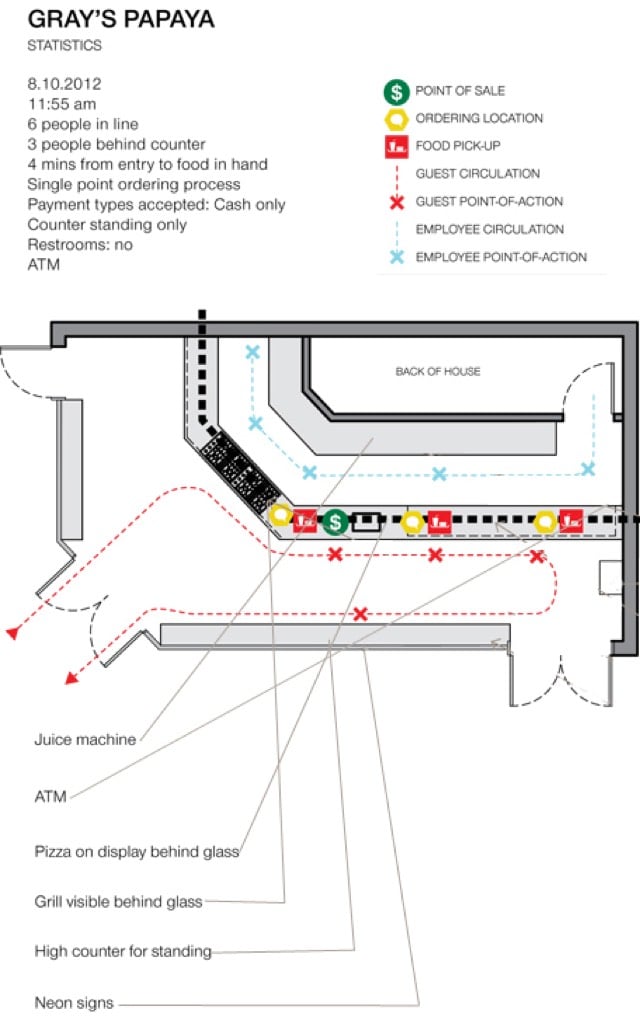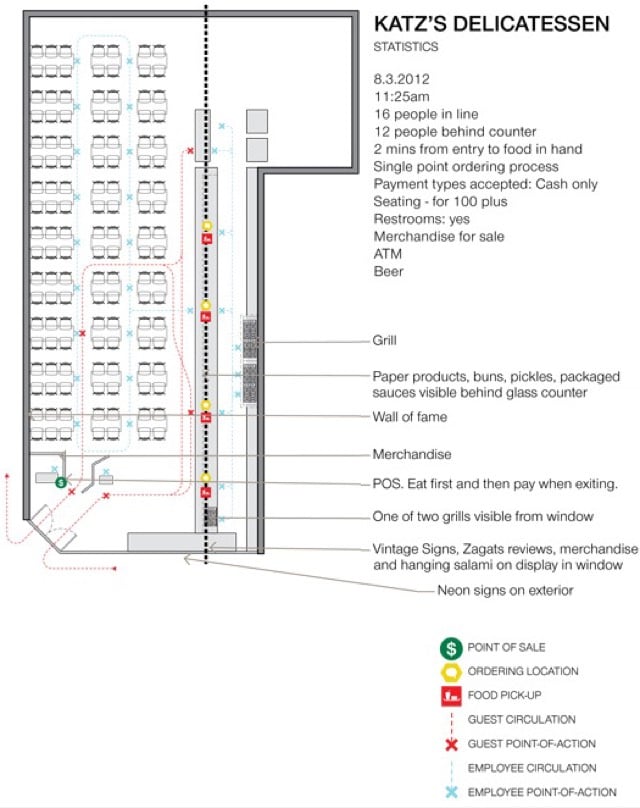When he was asked to design a new outpost of iconic NYC hot dog joint Papaya King in the East Village, Andrew Bernheimer went around to several other establishments in the city built to serve food quickly — Chipotle, Russ & Daughters, Katz’s, Shake Shack, Gray’s Papaya — and looked at their floor plans and flow of customers through their spaces. Mark Lamster talked to Bernheimer about the survey.


ML: I think at fast food joints we’re conscious that we’re in a very controlled environment, but perhaps don’t realize (because we are in a rush), just how manipulative that space can be. How did you see this playing out in the places you looked at?
AB: It ranged. Artisanal places (like Russ & Daughters) don’t feel manipulative in an insidious way at all (other than showing off some great food and triggering all sorts of synaptic response), while others do (Five Guys and their peanuts, a pretty nasty and obvious trigger to go order soda or spend money on WATER). We didn’t just look at fast food joints, but also icons of New York (R&D, Katz’s) that do try to serve people quickly but I don’t think qualify as “fast food joints.” In these cases the manipulation is either entirely subliminal and beyond recognition, or it has been rendered unnecessary because a place has become iconic, the domain of the “regular.”
Speaking as a customer, places like Katz’s and Russ & Daughters always felt like a total mess to me. Katz’s in particular is the worst: the whole thing with the tickets, paying on the way out, the complete lack of a single line, separate ordering locations for different types of food, etc.
That Gray’s Papaya that used to be on the corner of 8th St and 6th Ave, however, was fantastic. It had the huge benefit of being situated on the corner, but when you walked in, there was the food being cooked right in front of you. It was obvious where the line was and what direction it was moving. And after getting your food, you could exit immediately out the “back” door or circle back against the line to find a counter spot to quickly eat your meal.
My vacation reading: Master of Shadows: The Secret Diplomatic Career of the Painter Peter Paul Rubens by Mark Lamster.
Peter Paul Rubens gives us a lot to think about in his canvasses of rushing color, action, and puckered flesh, so it’s not surprising that his work as a diplomat and spy has been neglected. One of my goals in writing Master of Shadows was to fill that gap in the record. Here, after all, is an actual Old Master using actual secret codes, dodging assassination, plotting the overthrow of foreign governments, and secretly negotiating for world peace.
Certainly, a biographer could not ask for a more compelling subject. Rubens was a charismatic man of extraordinary learning, fluent in six languages, who made a fortune from his art. He never fit the paradigm of the artist as a self-destructive figure at odds with convention. More than one of his contemporaries actually thought his skill as a statesman surpassed his unmatched talent before an easel.
Art history page-turner? Yep.
Reporting for Design Observer, Mark Lamster visits the new CityCenter complex in Las Vegas.
There’s something dystopic about the place generally, and CityCenter is starting to feel like the world of Blade Runner come to life. I head back to my room, shut the black-out curtains and lie in bed. More people commit suicide in Las Vegas than in any other city in the United States.
But then, upon his return to NYC:
Drinks at Prime Meats, in Brooklyn, with my wife. Realistically, this place is as much an artifice as anything on the Strip, a re-imagining of a 19th-century saloon, complete with polished bar, antique typography, Edison bulbs. Why, then, does it feel so much more honest? Because its aesthetic is filtered through a contemporary sensibility? Because it seems a natural part of a vibrant neighborhood? Is this all bullshit I invent to make myself feel more comfortable?
In addition to being a painter of some repute, Peter Paul Rubens was also a diplomat:
In Master of Shadows, Mark Lamster tells the story of Rubens’s life and brilliantly re-creates the culture, religious conflicts, and political intrigues of his time. Commissions to paint military and political leaders drew Rubens from his Antwerp home to London, Madrid, Paris, and Rome. The Spanish crown, recognizing the value of his easy access to figures of power, enlisted him into diplomatic service. His uncommon intelligence, preternatural charm, and ability to navigate through ever-shifting political winds allowed him to negotiate a long-sought peace treaty between England and Spain even as Europe’s shrewdest statesmen plotted against him.
and a graphic designer.
Moretus was Rubens’s most frequent design client. To save his friend money, Rubens generally did his work for Plantin on holidays, so he would not have to charge Moretus his rather exorbitant day rate (Rubens was notorious for his high prices), and even then he agreed to be paid in books.







Stay Connected